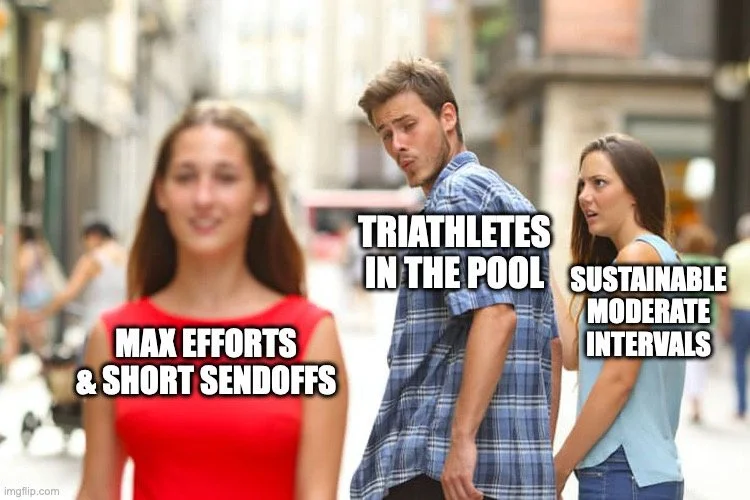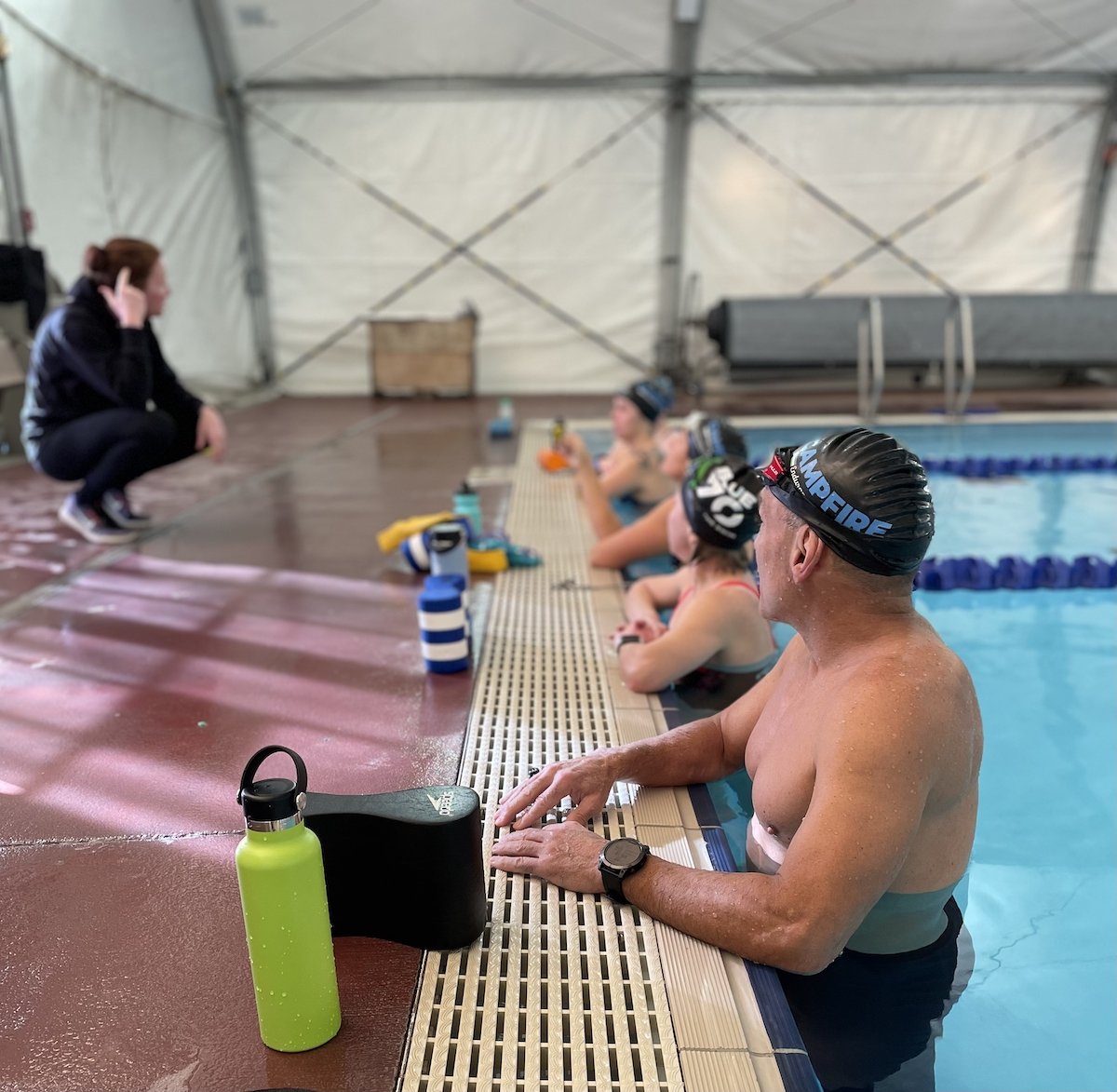You’re Swimming Too Hard for Triathlon
Slow Down, Breathe Easier, and Swim Better in 2023
by Chris Bagg and Molly Balfe
Triathlon is a mongrel sport, the strange offspring of swimming, cycling, and running, and like any mutt it does several things fairly well but tends not to excel at any particular endeavor. When looking for guidance, of course, triathlon tends to look to its parents for that direction, as many children would.
The problem is that swimming, cycling, and running in triathlon is different enough from its single-sport progenitors that seeking instruction from those sports can lead us as triathletes astray (also, if you’ve ever polled swimmers, cyclists, and runners you know that they tend to think about us in the same way that the Stark family first thought about poor Jon Snow). One of the primary areas of confusion is our relationship with swimming, the strangest of our three parents.
Swimming, as we’ve pointed out before, is a quadrupedal, horizontal activity conducted in an environment that can kill you. If you’ve been paying attention, you’ll know that humans are bipedal, vertical organisms that breathe oxygen, and not through gills. Swimming is essentially an alien activity, and since many triathletes are adult-onset swimmers, there’s a lot of confusion out there in the triathlon world about how to perform the most technical of the three disciplines in our sport.
Today we’re gonna talk about one of the biggest sources of confusion: how should triathletes train for swimming, and how similar or how different should that training be to single-sport swimmers? Spoiler: it should be different, but probably not different in the way you might be thinking.
Single-sport Swimmers are More Swim Fit
Well, duh, right? We promise this is important. When the two co-founders of Campfire were club swimmers in secondary and high school, we didn’t think twice about the long hours our teams mandated for us, hitting the water twice a day most days: 6am for about an hour, and then another two hours each weekday. For those of you counting at home, that’s about 15 hours of training a week, and very often there would also be weekend sessions or meets. Single-sport swimmers swim…a lot. Very often those at the tippy-top of the swimming scene would train over 1000 hours a year, which is in the 20 hours/week range, or a similar amount of time to develop the fitness to qualify for Kona for most amateur triathletes. Why so much when most swimmers’ events take place over minutes, not hours? Well, we know now that although race specificity is important for training, having a high level of fitness (conditioning, endurance, aerobic yards…it’s all the same idea) will give you all of the adaptations necessary to train at higher and higher intensities. The same truth has held sway in cycling and running for decades: the great Arthur Lydiard had his Olympic 800m runners and his marathons running 100-mile weeks back in the 1960s and 1970s. Cyclists log thousands of endurance miles in order to build the physiology necessary to run LOTS of oxygen through their systems when they’re doing their hard training.
Why is this important? You probably know that endurance training is important (heck, the endurance world is in one of its pendulum swings, with “Zone 2” training suddenly taking the reins from the HIIT craze of the past decade), so why are we hitting this particular note again? Well, as we said above, triathletes tend to look to their parents for training advice, but in this context it’s very easy to misunderstand what single-sport swimmers are doing. Those swimmers are orders of magnitude more swim-fit than triathletes (they’re swimming 15-20 hours a week versus triathletes managing 2-7 hours a week—not even the same galaxy), so we need to separate our sport from theirs in order to train more effectively.
A Mismatch of Intentions
When a triathlete looks at a swimmer’s workout, it can be easy to think that that’s the model. Two workouts stand out for the two of us from our high school days, and there wasn’t anything too special about these sessions. We offer them here as an example to see just how different these sessions are. Usually the evening practices began with 5-600 yards of easy warming up, and then another 4-500y of 50s or 75s to get the heart rates turned up a bit. Then a main set like the one below:
7x(8x100 yards on a 1:20 sendoff, 100 easy on a 2:00 sendoff).
We’ll do the math for you: that a 6300y main set, or the distance that many triathletes will swim in a week. The other eye-popping number? That 1:20 sendoff, which for most triathletes will be in the AS HARD AS FREAKING POSSIBLE mode. For a fit high school club swimmer, however, this workout is just a normal aerobic set, nothing hard about it, and the intervals are here for keeping distractible minds from getting bored. We’d swim our 100s in a comfortable 1:12-1:15 and then flirt with each other during the longer rest period of that easy 100. The whole GOAL of this set was to log a bunch of consistent effort yards.
Many triathletes, however, will look at this practice and see the swimmers leaving after only 5-8 seconds of rest and think “Whoa, that must be a really hard set, they’re swimming so fast and taking so little rest! I probably need to be swimming like that!”
But settle down, Broheim! As we pointed out earlier, swimmers are a lot more swim-fit than triathletes. They can HANDLE this volume and pace easily. Unfortunately, this style of swimming (and the “harder must be better” mindset) has infiltrated swimming for triathlon. Triathletes, understandably, usually try to cram as much stimulus as possible into each unit time as they can; they are busy people with lots of logistical demands. Sadly, though, just as with the other sports, swimming too hard all the time only creates more fatigue and usually not more fitness. Broheim will look at that swim workout above and maybe cut it to ⅓ of the total distance, doing something like 18x100 on 1:30 (triathletes are always cutting out the easy intervals), and swimming as hard as he can and only getting 2-3 seconds of rest between 100s. Broheim is going to be a red-faced mess about 10 100s in, and may not actually complete the workout. After the workout, he’s likely to say something like “Yo, BRO! That session was EPIC I was getting crushed but I can totally tell it’s making me FASTER!”
We’ll pause here for Broheim’s misplaced enthusiasm to fade a little. The problem, Broheim, is that you’re likely doing this same session (or one like it) 3-4 times per week, basically performing best effort, short rest intervals every single day.
Is that how you would train for cycling or running? Running surely not, because you’d be injured in a week. Cycling would take a little longer, and rather than injury you’d simply be so fatigued from your constant diet of anaerobic and VO2max training that you’d probably start to get sick or burned out before injury, but it would certainly happen. But triathletes (and a lot of their coaches) confuse “difficulty” with “productivity” in the pool. “Swimming is low-impact/no-impact,” they seem to be saying “So we can train as hard as we can all the time, right?” Wrong. Here’s a small table that might illustrate our point:
It’s a well-established fact that your training needs to be a differentiated diet: mostly endurance, some hard work, not too much (apologies to Michael Pollan). Most triathletes, however, train in the pool as if the only workout available to them is DESTROY THE UNIVERSE. Don’t destroy the universe. Don’t be Broheim. It’s not epic.
What Should We Do Instead?
The short answer is that you should slow down in most of your workouts. Pick sessions that allow you to accrue a fair amount of yards/meters for YOU (don’t do other people’s sessions!) at a moderate effort. During your rest intervals you should be able to hear your breath, but you shouldn’t be gasping or feel like you’re dying. You should be able to talk with your lane mates during the 5-15” rest you have between intervals. Once a week is enough for a threshold session, but even those should only be in the “challenging but doable” range, or 7-8/10 effort. And then maybe every 10-14 days is a time for some truly hard swimming, but if you’re going to do really fast swimming, you actually need more rest (see our last post about sendoffs). The classic pool swimmer set for this is 10x100 on a 4:00 sendoff, and that send-off is for swimmers who will go under 60” for their 100 freestyle meet times! So for a triathlete a true “speed” session would be something like 8x100 on 5:00. We can’t remember the last time we saw a triathlete hanging out on the wall for 2:30-3:30, but maybe, just maybe, after reading this article, those triathletes may think about changing the way they swim in order to start getting faster, fitter, more efficient, and happier about their swimming.




